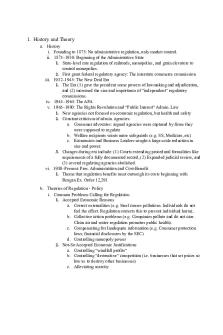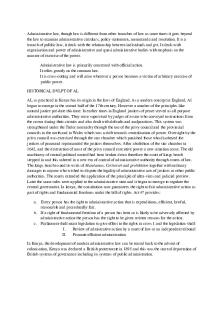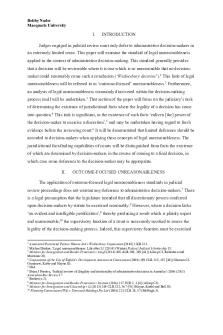Administrative Law Essay (Distinction - 2019 ) PDF

| Title | Administrative Law Essay (Distinction - 2019 ) |
|---|---|
| Author | Bobby Nader |
| Course | Administrative Law |
| Institution | Macquarie University |
| Pages | 5 |
| File Size | 199.4 KB |
| File Type | |
| Total Downloads | 21 |
| Total Views | 172 |
Summary
Distinction Essay - 2nd place in ALPSA Essay Competition (2019-2020)...
Description
Bobby Nader Macquarie University
I.
INTRODUCTION
Judges engaged in judicial review must only defer to administrative decision-makers in an extremely limited sense. This paper will examine the standard of legal unreasonableness applied in the context of administrative decision-making. This standard generally provides that a decision will be reviewable where it is one which is so unreasonable that no decisionmaker could reasonably come such a conclusion (‘Wednesbury doctrine’).1 This limb of legal unreasonableness will be referred to as ‘outcome-focused’ unreasonableness.2 Furthermore, an analysis of legal unreasonableness commonly discovered within the decision-making process itself will be undertaken.3 That section of the paper will focus on the judiciary’s task of determining the existence of jurisdictional facts where the legality of a decision has come into question.4 This task is significant, as the existence of such facts ‘enliven [the] power of the decision-maker to exercise a discretion’,5 and may be undertaken having regard to fresh evidence before the reviewing court.6 It will be demonstrated that limited deference should be accorded to decision-makers when applying these concepts of legal unreasonableness. The jurisdictional fact-finding capabilities of courts will be distinguished from facts the existence of which are determined by decision-makers in the course of coming to a final decision, in which case some deference to the decision-maker may be appropriate. II.
OUTCOME-FOCUSED UNREASONABLENESS
The application of outcome-focused legal unreasonableness standards in judicial review proceedings does not warrant any deference to administrative decision-makers.7 There is a legal presumption that the legislature intended that all discretionary powers conferred upon decision-makers by statute be exercised reasonably.8 However, where a decision lacks ‘an evident and intelligible justification’,9 thereby producing a result which is plainly unjust and unreasonable,10 the supervisory function of a court is necessarily invoked to assess the legality of the decision-making process. Indeed, this supervisory function must be exercised 1
Associated Provincial Picture Houses Ltd v Wednesbury Corporation [1948] 1 KB 223. Michael Barker, ‘Legal unreasonableness: Life after Li’ [2014] (Winter) Federal Judicial Scholarship 15. 3 Minister for Immigration and Border Protection v Singh (2014) 308 ALR 280, 289 [44] (Allsop CJ, Robertson and Mortimer JJ). 4 Corporation of the City of Enfield v Development Assessment Commission (2000) 199 CLR 135, 155 [48] (Gleeson CJ, Gummow, Kirby and Hayne JJ). 5 Ibid. 6 Brian J Preston, ‘Judicial review of illegality and irrationality of administrative decisions in Australia ’ (2006) 28(1) Australian Bar Review 17. 7 Barker (n 2). 8 Minister for Immigration and Border Protection v Stretton (2016) 237 FCR 1, 3 [4] (Allsop CJ). 9 Minister for Immigration and Citizenship v Li (2013) 249 CLR 332, 367 [76] (Hayne, Kiefel and Bell JJ). 10 Planning Commission (WA) v Temwood Holdings Pty Ltd (2004) 221 CLR 30, 57 (McHugh J). 2
Bobby Nader Macquarie University
by a court without any deference to the decision-maker, as its improper decision-making processes gave rise to the injustices suffered by the aggrieved party.11 Minister for Immigration v Singh (“Singh”) was illustrative of a court reviewing a decision on the grounds of legal unreasonableness.12 Singh requested an adjournment of a hearing to obtain a remarking of an English language test, which was refused by the Migration Review Tribunal. This occurred notwithstanding the tribunal accepting that Singh should be entitled to take the test prior to the making of its decision. Accordingly, the court held that the decision lacked intelligible justification.13 The timeframe in which the test could have been reassessed was relatively short, the test had been inaccurately assessed in the first instance and ultimately, the ramifications of denying the request were significant for Singh.14 Singh demonstrated that it may be necessary for a court to review the outcome of a decision in order to restrict the ‘genuinely free discretion’15 conferred upon decision-makers in this context. Notwithstanding its skill and expertise in handling matters within the field of migration, deference to the tribunal was unnecessary, as it was the outcome of the decision which was being reviewed by the court. A. Unreasonableness: A Review of the Merits? It is frequently argued that judges reviewing an administrative decision on the grounds of legal unreasonableness are effectively undertaking a merits review of the decision.16 That is, judges engaged in judicial review may at will review and disapprove of decisions in light of their own differing perceptions of ‘unreasonableness’, and suggest that matters be dealt with in accordance with those perceptions.17 This would offend the legality/merits distinction, which provides that a court undergoing judicial review is not to substitute their decisions for those of the primary decision-maker.18 Rather, the court is to assess the legality of the decision itself.19 However, the following propositions may be asserted in response to these criticisms. The Wednesbury doctrine imposes a high threshold for establishing legal unreasonableness, requiring ‘something overwhelming’20 to enliven the rule. In Minister for
11
Preston (n 6) 14. Minister for Immigration and Border Protection v Singh (2014) 308 ALR 280. 13 Barker (n 2). 14 Minister for Immigration and Border Protection v Singh (2014) 308 ALR 280, 294 [73] (Allsop CJ, Robertson and Mortimer JJ). 15 Minister for Immigration and Citizenship v Li (2013) 249 CLR 332, 363 [66] (Hayne, Kiefel and Bell JJ). 16 Margaret Allars, ‘Chevron in Australia: A Duplicitous Rejection?’ (2002) 54 Administrative Law Review 569, 581. 17 Associated Provincial Picture Houses Ltd v Wednesbury Corporation [1948] 1 KB 223, 230. 18 Peter Cane, ‘Merits Review and Judicial Review – The AAT as Trojan Horse’ (2000) 28(2) Federal Law Review 213, 220. 19 Ibid. 20 Associated Provincial Picture Houses Ltd v Wednesbury Corporation [1948] 1 KB 223, 230. 12
Bobby Nader Macquarie University
Immigration v Eshetu,21 Gleeson CJ and McHugh J emphasised that the standard of legal unreasonableness is not to be viewed as an alternative or arbitrary method available to a judiciary for expressing its disapproval of a decision.22 Similar conclusions were arrived at in Minister for Immigration v Li (“Li”).23 Thus, courts are well aware that the standard of legal unreasonableness is an exceptional ground of review, and that its requirements are not easily satisfied. Furthermore, the Wednesbury doctrine has not been regularly invoked since its formulation. The doctrine has been successfully invoked just three times since the decision in Li was handed down.24 As plurality in Li asserted, the doctrine is concerned with the avoidance of instances where a court is unable to identify how a decision was arrived at, such decision lacking ‘evident and intelligible justification’.25 In this context, a court’s interest lies not in substituting its own decision for that of an administrative decision-maker, but rather emphasising the importance of rational decision-making. III.
EXISTENCE OF JURISDICTIONAL FACTS
A reviewing court must independently determine the existence or non-existence of jurisdictional facts.26 The rejection of the Chevron doctrine in Corporation of the City of Enfield (“Enfield”),27 was significant in the context of jurisdictional fact-finding. The Chevron doctrine provides that a court ‘should defer to administrative interpretations of ambiguous legislation.’28 Resultingly, its application may undesirably encourage a decisionmaker to adopt one of many potential interpretations of the relevant statute. Decision-makers may then mould the facts of a case to satisfy the relevant criterion necessary to establish jurisdiction and make a decision.29 These findings facilitated the rejection of the idea of judicial deference to administrative fact-finding all-together.30 Furthermore, constitutional considerations advance such a proposition, considering the significance of assuming the existence of jurisdictional facts in the decision-making process. In Timbarra Protection Coalition,31 Spigelman CJ affirmed that determining the question of whether or not a factual 21
Minister for Immigration and Multicultural Affairs v Eshetu (1999) 197 CLR 611. Ibid 626 (Gleeson CJ, McHugh J). 23 Minister for Immigration and Citizenship v Li (2013) 249 CLR 332. 24 Minister for Immigration and Border Protection v Singh (2014) 308 ALR 280; SZRHL v Minister for Immigration and Citizenship [2013] FCA 1093; SZSNW v Minister for Immigration and Border Protection [2014] FCCA 134. 25 Minister for Immigration and Border Protection v Singh (2014) 308 ALR 280. 26 Corporation of the City of Enfield v Development Assessment Commission (2000) 199 CLR 135, 155 [48] (Gleeson CJ, Gummow, Kirby and Hayne JJ). 27 Ibid. 28 Preston (n 6) 26. 29 Corporation of the City of Enfield v Development Assessment Commission (2000) 199 CLR 135, 152 [42] (Gleeson CJ, Gummow, Kirby and Hayne JJ). 30 Preston (n 6) 26. 31 Timbarra Protection Coalition v Ross Mining NL (1999) 46 NSWLR 55. 22
Bobby Nader Macquarie University
issue is considered to be one of jurisdictional fact is a matter of statutory construction.32 Where a reviewing court determines the existence or non-existence of a jurisdictional fact, that is, whether parliament intended that the fact be an essential pre-cursor to the decisionmaker’s powers, it implements a supervisory function in relation to the boundaries of the powers exercisable by the executive.33 By exercising this function, the judiciary is fulfilling its constitutionally prescribed duty, that is, ‘to say what the law is’,34 having regard to its intended meaning prescribed by parliament. Ultimately, these considerations collectively suggest that judges engaged in judicial review should not defer to administrative findings of jurisdictional facts. A. Administrative Decision Makers’ Expertise in the Field: Is Some Deference Necessary? However, where the evidence considered by the reviewing court in determining the existence of a jurisdictional fact is substantially similar to that of the primary decision-maker, it has been argued that a degree of deference should be accorded to the decision-maker.35 In Enfield, Gaudron J suggested that weight is to be given to the decision-maker’s finding in such a context particularly where the decision-maker possesses expertise within the relevant field.36 Furthermore, Kirby J in Minister for Immigration v Wu Shan Liang37 asserted that decision-makers will typically possess greater experience in the ‘consistent application of applicable administrative rules’.38 Contrary to these arguments, and as previously asserted, ascertaining whether or not a jurisdictional fact exists is primarily a matter of statutory construction.39 The judiciary must carry out such a task when called upon by an aggrieved party, and to do any less is ‘to abdicate judicial responsibility’.40 Furthermore, analysing a decision-making body’s internal processes and perspectives in coming to a conclusion, as well as ensuring that such processes are duly complied with, is difficult. Opposingly, the judiciary’s obligation to act impartially and to uphold exemplary standards of transparency in
32
Ibid 64 [39] (Spigelman CJ). Preston (n 6) 19. 34 Marbury v Madison, 5 US 87, 111 (1803). 35 Corporation of the City of Enfield v Development Assessment Commission (2000) 199 CLR 135, 156 [51] (Gleeson CJ, Gummow, Kirby and Hayne JJ). 36 Ibid. 37 Minister for Immigration and Ethnic Affairs v Wu Shan Liang (1996) 185 CLR 259. 38 Ibid 292 (Kirby J). 39 Timbarra Protection Coalition v Ross Mining NL (1999) 46 NSWLR 55, 64 [39] (Spigelman CJ). 40 Corporation of the City of Enfield v Development Assessment Commission (2000) 199 CLR 135, 158 [60] (Gaudron J). 33
Bobby Nader Macquarie University
determining these critical factual issues will undermine any argument to accord deference to decision-makers in this regard. 1. Immaterial Findings of Fact: Efficient Decision Making These considerations suggest that deference may be given to decision-makers for findings of fact which may be viewed as a ‘step along the way in a course of reasoning leading to an ultimate decision’.41 Such a proposition may carry weight in the interests of limiting what critics have argued is an over-expansive scope of judicial review. Deference in this context promotes efficiency in the handling of administrative matters, by reducing the grounds by which a party may seek review of a seemingly immaterial finding of fact. Furthermore, respect is accorded to decision-makers’ abilities to assume the existence of obscure facts which may only be conclusively determined by a body with expertise in the field concerned.42 However, where such findings of fact lead to a final decision which is unreasonable, particularly in a Wednesbury sense, a reviewing court may assess the legality of the decision-making process. This point emphasises the limited scope for deference to administrative decision-making, particularly in the context of fact-finding. IV.
CONCLUSION
The extent to which judges engaged in judicial review should defer to administrative decision-makers is extremely limited. This proposition was considered in light of the Wednesbury doctrine, and its application in outcome-focused unreasonableness. Furthermore, the duty of reviewing courts to conclusively determine the existence of jurisdictional facts was also explored. It was determined that some deference may be accorded to decisionmakers in the context of non-jurisdicitonal fact-finding. But ultimately, the application of the standard of legal unreasonableness contemplates little deference to administrative decisionmakers.
41 42
Australian Broadcasting Tribunal v Bond (1990) 170 CLR 321, 337 (Mason CJ). Minister for Immigration and Multicultural Affairs v Eshetu (1999) 197 CLR 611, 655 [140] (Gummow J)....
Similar Free PDFs

Administrative Law - Essay
- 5 Pages

Administrative Law 70617 - Essay
- 14 Pages

Administrative Law - Admin Law
- 6 Pages

Evidence Essay - Grade: Distinction
- 10 Pages

Administrative Law Outline
- 33 Pages

Administrative law (4th)
- 59 Pages

Administrative Law Outline / Summary
- 46 Pages

Administrative LAW MERITS REVIEW
- 38 Pages

Administrative Law Outline
- 14 Pages

Administrative law Notes Kenya
- 10 Pages

Canadian Administrative Law
- 54 Pages

Administrative LAW I Notes
- 90 Pages

Administrative Law Summary Notes
- 90 Pages

Administrative Law notes
- 32 Pages
Popular Institutions
- Tinajero National High School - Annex
- Politeknik Caltex Riau
- Yokohama City University
- SGT University
- University of Al-Qadisiyah
- Divine Word College of Vigan
- Techniek College Rotterdam
- Universidade de Santiago
- Universiti Teknologi MARA Cawangan Johor Kampus Pasir Gudang
- Poltekkes Kemenkes Yogyakarta
- Baguio City National High School
- Colegio san marcos
- preparatoria uno
- Centro de Bachillerato Tecnológico Industrial y de Servicios No. 107
- Dalian Maritime University
- Quang Trung Secondary School
- Colegio Tecnológico en Informática
- Corporación Regional de Educación Superior
- Grupo CEDVA
- Dar Al Uloom University
- Centro de Estudios Preuniversitarios de la Universidad Nacional de Ingeniería
- 上智大学
- Aakash International School, Nuna Majara
- San Felipe Neri Catholic School
- Kang Chiao International School - New Taipei City
- Misamis Occidental National High School
- Institución Educativa Escuela Normal Juan Ladrilleros
- Kolehiyo ng Pantukan
- Batanes State College
- Instituto Continental
- Sekolah Menengah Kejuruan Kesehatan Kaltara (Tarakan)
- Colegio de La Inmaculada Concepcion - Cebu

